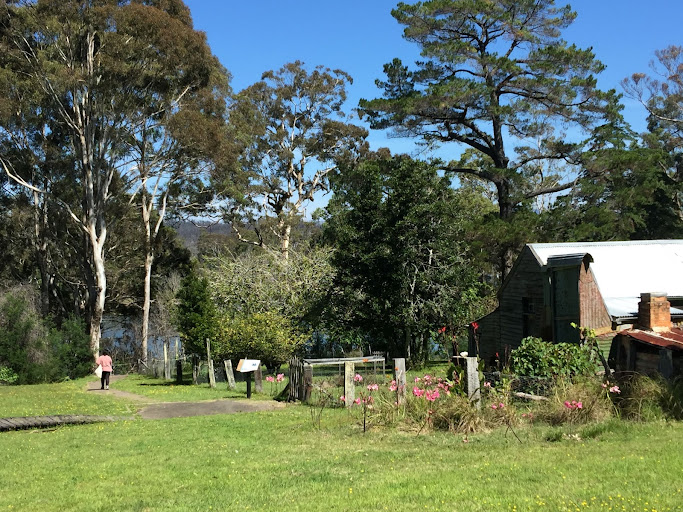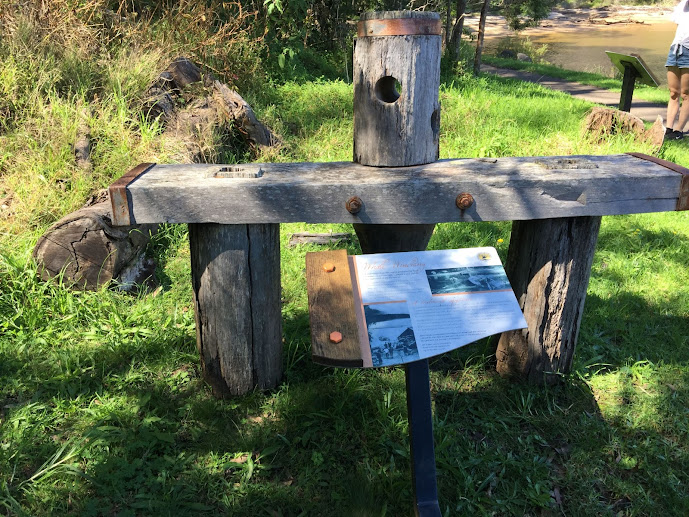 We stayed at Ingenia Holiday Park just south of Eden and travelled the short distance of 30 mins - 29km, to the Whaling Station. We went to have a look at Boyd's Tower first, but the road in was closed. So off to the Davidson Whaling Station.
We stayed at Ingenia Holiday Park just south of Eden and travelled the short distance of 30 mins - 29km, to the Whaling Station. We went to have a look at Boyd's Tower first, but the road in was closed. So off to the Davidson Whaling Station. Located on the Kiah Inlet at Twofold Bay, Davidson Whaling Station was the longest running shore-based whaling station in Australia, and the last of its type to close. It is a short walk from the car park to the old dwellings, now a private residence, ....
Located on the Kiah Inlet at Twofold Bay, Davidson Whaling Station was the longest running shore-based whaling station in Australia, and the last of its type to close. It is a short walk from the car park to the old dwellings, now a private residence, ....This is where the Davidson family set up their home and whaling station. Three generations of the Davidson family operated this station using traditional bay-whaling techniques using open boats and hand held harpoons. They were also assisted by a pack of killer whales, or orcas, who would drive the Southern Right and Humpback whales up onto the beach. The area has interpretative signs and easy walkways.
The Davidson home, named Loch Garra, was built about 1896 and is situated on 17 acres of freehold land and was planted with fruits, vegetables and beautiful gardens. The family of 10 : George and Sarah, and their eight children, Jack, Effie, Roy, Sarah, Jim, Wallace, Elsie and Carrie also had chickens and dairy cows making the family mostly self sufficient.
However, that was not the first house on the property. In 1857 Alexander Davidson, George's grandfather, built Kiah House opposite from where Loch Garra was built. He built the house using material from the shipwreck of the Lawrence Frost. Kiah House was destroyed by fire in 1926.
The Whaling Station was established by Alexander Davidson in 1826 and was built using equipment purchased from the failed Ben Boyd whaling station. The Davidson's used green coloured boats, the colour of the traditional Davidson tartan, and used harpoons instead of guns. It is believed the orcas could recognise the green colour and as the harpoons were quiet they felt safe to help the whalers. Remnants of equipment can be found throughout the property.
A short walk from the homestead along a wooden boardwalk and dirt path takes one down to the beach on the left and the old whaling equipment on the right.
The Orca's would spot a whale and head to the station to alert the whalers by slapping their tails on the surface of the water, known as flop-tailing. The whalers would head out to the location, guided by the orcas. The orcas would 'corral' the baleen whales towards the whalers, where they were harpooned until they died. The next day the whalers would pull the dead whale back to the station using metal ropes and the assistance of the orcas.
At the station the whale was processed. This a replica of a whale winch, a capstan, which was used to hold the whale carcass in place while the blubber was being striped.
Thick layers of blubber were removed and boiled in water until the oil rises to the top. The oil overflowed into gutters and into try-pots to cool before being put into barrels. The off cuts were thrown on the fire to keep the water boiling. Try-pots had been in this bay back in the 1840's when a Hawaiian man, Otaheti Bill, set up his try-pots in the bay.
The oil was used for lighting and soap. The try-works was last used in 1929, and fell into disrepair. The whalers would only catch about 8 whales a year, and only the whales that the orcas had been naturally hunting. The local Aboriginal people observed the nature of the killer whales, orcas, and developed ways to benefit from their behaviour. George Davidson also learnt from orca behaviour and used it to his advantage. The Davidson Whaling Station operated until 1932. George Davidson and his family lived in Loch Garra until 1945. There is so much information at the Eden Killer Whale Museum.
Entry into the Whaling Station is free, and well worth a visit. Take a picnic lunch and enjoy the beach.










No comments:
Post a Comment